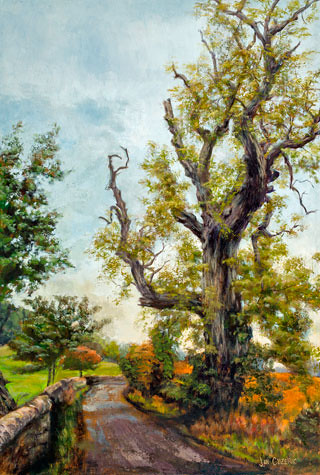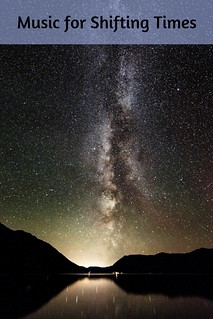Artist of the Month: Jan Clizer
I knew at first glance that our featured artist, Jan Clizer, truly understands how to share the essence of place. Her paintings are utterly evocative, and whatever the subject, take us around the world. I love them - and so will you.
Jan Clizer’s professional painting career stretches over two and a half decades and far from the Pacific Northwest, across the Atlantic Ocean. Her current focus is a large commissioned series of representational landscape work celebrating the beautiful, rugged Okanogan Country of her native Washington State, made possible by Scottish musical connections. A lifelong passion for Scottish and Celtic cultures strongly influences this versatile painter’s subject matter. She paints, exhibits, and plays fiddle in both Scotland and Northern Idaho, as family and painting responsibilities permit. Her paintings are collected and commissioned on both sides of the Atlantic, while selected images are available as quality reproductions.
She notes, “I am a fine art painter and musician whose focus of creative expression is inspired by the culture, history and landscape of Scotland. An American of Scots/Cornish/Irish/German ancestry, my lifelong passion for Scottish culture and Celtic music have resulted in repeated trips 'across the pond.' Extensive stays since 2003 have taken me down many interesting tracks, actively participating in local village and city life in North Scotland. Supportive friends and patrons include me in sailing adventures, work parties, road trips, and all manner of music and local events, enhancing knowledge of Scottish culture firsthand.
Simply put, art and music are my life....past, present and future. A self-taught painter raised in the coastal NW US, my strong desire to 'put marks on something' as a small child were firmly discouraged. In 1980, living in a ruggedly beautiful area of the US West, I took up pencil and brush. Two children and making a living put painting in the background for a substantial period, but the desire and inspiration remained constant.”

Travelling in Scotland
How long have you been an artist?
I decided to go ‘professional’ with my art a little over two decades ago, after ‘dabbling’ with increasing intensity for 15 years. I had been emphatically discouraged from an early age… my mother was a gifted but frustrated painter herself, wanting to save me from experiencing the struggles and disappointments she had encountered. It took many years to get past the negative connotations attached to creating art and gradually embrace what had been taboo for me as a child. I still deal with it regularly!

Tight Line, No. 17
Is art your full-time career?
Basically. I have played fiddle in two bands and solo in the area for years, playing both Celtic and folk, but painting is requiring that I make a difficult choice, as it is requiring almost all my time and focus. I am thrilled to be recognized for my abilities with more and more commissions, but it’s tough to let the fun and craziness of live music performance go… for now….

Celtic Fiddle Series No. 4

Celtic Fiddle Study No.2
Where do you work? How long have you been there?
I now live and work at my home in Coeur d’Alene, in northern Idaho. My 18’ x 24’ studio is a small, old four-stall horse barn on my place, renovated in 2010 to give me a place to breathe, sleep, and paint in between caring for my elderly parents. It is now given over completely to studio space and a large Hughes easel, but my custom-built log bed is staying put! It hasn’t always been this easy. For years, creating was fraught with frustration as I set up to draw or paint just about anywhere a space could be made in our current residence … usually the dining table. Things had to be set up, put away, then set up again. Great training for four years on the road with paints! From 2004 through 2007, I lived and explored in Scotland and set up my paints and pochade box in lots of odd places—friends’ spare rooms, gardens, harbours … city streets and country lanes. Making good progress on a painting was quite difficult … not only was the weather a consistent challenge, but well-meaning locals were quite the menace to my career, wanting to critique, tell me of their relative who paints, pass the time of day, and tell me their version of the history of the area starting from William Wallace’s time in the 1300’s. Frustrating. Hilarious. And abso-lutely priceless memories!

Time Off

Dryburgh Ancient
Do you have favorite places you like to create?
I prefer to create in my studio, just for comfort, minimal possible distractions, and convenience. Putting in windows has given the barn a wonderful atmosphere, and I love the pleasant, peaceful ambiance. I still love painting outside, but both my current commission work and UK—focused work is done with charcoal drawing and photo reference material, so I’m better off inside.

The Old Mill Site

Florida looking at Texas
What does a typical day look like? Is there a typical day?
Here is a current typical workday...usually four days a week. More when possible. The other three are taken up with family, music practice, and performance, extra marketing, processing and packaging prints and originals for shipment:
• Meditation, yoga, journaling, breakfast, whatever household chores I can fit in before 9 am
• Tend to 4 pet hens and tour the veg garden, build a fire in woodstove if needed, set out paints, be ready to roll by 10 am
• Paint with short breaks & snacks every 1 1/2 hrs till 5-6pm / business and personal calls on breaks
• Dinner prep & break /personal calls
• Computer work (emails, promo, marketing) till eyes reach closing point

Morning in MacDuff

Gateway to the Cuillins

Dunnotar From the Sea
What materials do you prefer?
My favourite materials are good quality oils on linen, and pastels/charcoal on heavily toothed papers. I find oil paint an absorbing and very rewarding medium to work in. It feels somewhat like playing with brushes and palette knives in different colours of butter! Some people make it look so easy to manipulate and apply paint in just the right way …. Aye …. right! I doubt working with it could ever become boring. I love the woven texture and irregularities of linen, which help give character to a piece. I did a painting on a section of an antique (late 1800’s) linen bedsheet from an estate in north Scotland—sheer joy to work on! (Gan ’Aim, below) And there is NOTHING like the velvety feel of applying charcoal. Layering/blending pastels is fascinating, especially on papers whose strong texture adds to the dimension of the image you’re creating. We are incredibly spoiled for choice with so many options for artistic expression available to us!

Gan ‘Aim
Where/how are you inspired?
Inspiration just happens, wherever I am, and it is truly a frustration! As I began taking art more seriously, research revealed that an artist needs to have a theme or focus for his/her work. Me being me, I just couldn’t stick the idea of doing a series of say 20 paintings of sunflowers, or hedgehogs, or whatever. I have friends who turn out paintings of bear after bear after moose after another bear here in the Northwest and make a good living from it. I’d go mad. So I turned to what gets my blood up and where my interests have been focused since a small child—Celtic music and Scottish/Celtic culture. Granted, it’s rather daft, but the saying ‘paint what you love’ isn’t far off the mark. I believe that greater understanding of our various cultures is of major importance to our own quality of life and those who follow in our footsteps. I am inspired to share with others my appreciation of the cultures I am descended from. Cultural subjects in the Scottish and Celtic genre can be pretty widely interpreted—I can paint a seascape, a highland cow, a rural landscape, a harbour scene, or the stonework on a headstone, get away with changing subject matter with each new painting, and it’s all in the stated focus of my work! Everything is so old in the UK, it feels like every square inch is so full of history, offering endless stories to contemplate in paint.

Uig-Highlander

Memento Mori

Marjory’s Shed
How do you know when your piece is done?
Being a representational painter, it must be easier to determine a completion point for a piece than say an abstractionist. It depends on the style of the piece I’m working on and the feeling I’m attempting to convey, but I hope I’ve developed a bit of an instinct to know when to quit, to avoid ‘licking it to death!’

Miss Tia Maria
Do you work on one or more pieces at a time?
I normally have multiple pieces on the go simultaneously, especially with commission work. For me, creating something with the idea of pleasing another pair of eyes (or in my current commission series, several pair!), is extremely stressful, so switching between two or three paintings helps to keep me from getting too focused on any one piece. I also like to loosen up as I work on a large realistic piece by slipping in a small, quick, more impressionistic work now and again. Completing a small painting in two or three hours gives me reassurance that the big, seemingly endless piece in progress will indeed eventually become a successful finished painting also!

Looking to Scotland, Giant’s Causeway

Beauly Firth
If you were not a painter, what would you do?
If I wasn’t a painter, I’d be a full-time musician, a traditional Celtic / Folk fiddler, as I do now, just on a full-time level. I’d also be proficient on bodhran (irish drum), bouzouki, and uillian pipes. I have a strong case of PTSD. I’m pretty much a non-starter at expressing myself out loud, and music has been THE outlet for feelings and emotions since I was six. The enjoyment of creating and experiencing music and painting enhance my life immeasurably, and I hope it lifts the lives of others also.

Calling Up the Tunes
How can our readers find and purchase your art?
You can view, comment on, and purchase my original works and a selection of giclée prints online at the following sites, and if you are in the area, studio visits are welcomed by appointment.

The Observer
• Amazon
My sincere thanks to Dr. Jessie Voigts for this opportunity to share my work with a wider audience!
All photos courtesy and copyright Jan Clizer




















